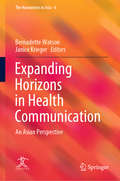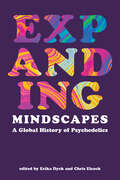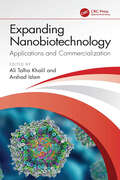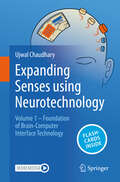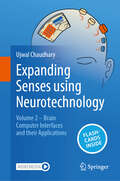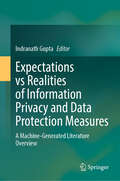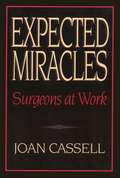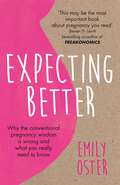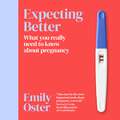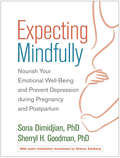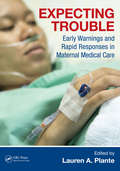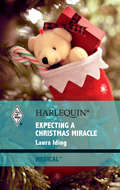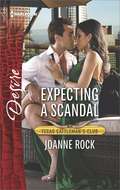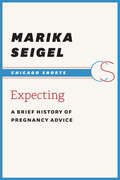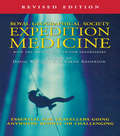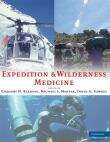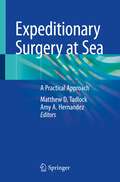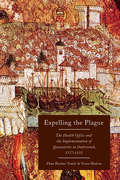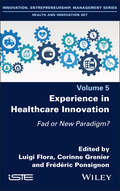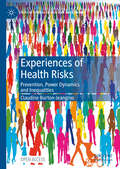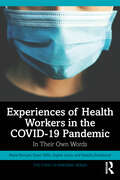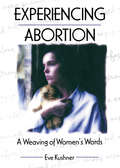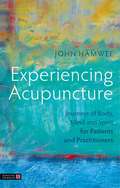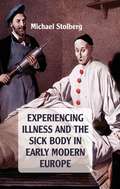- Table View
- List View
Expanding Horizons in Health Communication: An Asian Perspective (The Humanities in Asia #6)
by Bernadette Watson Janice KriegerThis book explores the ways in which Eastern and Western medical knowledge inform each other in the treatment of people in Asia across a wide range of health issues. To do so, it brings together health communication scholars from diverse disciplines both in Hong Kong and worldwide and combines their observations and expertise with those of clinicians working in healthcare in Asia to provide a topical portrait of the expanding horizons of healthcare in Asia. Social scientists and clinicians discuss their research and clinical practice respectively using a range of analytic approaches that include traditional qualitative and quantitative methodologies, as well as cutting-edge computer diagnostics that digitally visualize health interactions across time. The book presents an innovative and interdisciplinary investigation of Eastern and Western perspectives on healthcare in Asia. It covers topics concerned with a range of mental and physical problems that are currently confronting Asia. Importantly, the views and experiences of front line clinicians delivering patient care in Asia are also included. Accordingly, the book offers varied and innovative perspectives on health communication issues in China, Singapore, Bangladesh and Australia.
Expanding Mindscapes: A Global History of Psychedelics
by Erika Dyck and Chris ElcockThe first collection of its kind to explore the diverse and global history of psychedelics as they appealed to several generations of researchers and thinkers.Expanding Mindscapes offers a fascinatingly fluid and diverse history of psychedelics that stretches around the globe. While much of the literature to date has focused on the history of these drugs in the United States and Canada, editors Erika Dyck and Chris Elcock deliberately move away from these places in this collection to reveal a longer and more global history of psychedelics, which chronicles their discovery, use, and cultural impact in the twentieth century.The authors in this collection explore everything from LSD psychotherapy in communist Czechoslovakia to the first applications of LSD-25 in South America to the intersection of modernism and ayahuasca in China. Along the way, they also consider how psychedelic experiments generated their own cultural expressions, where the specter of the United States may have loomed large and where colonial empires exerted influence on the local reception of psychedelics in botanical and pharmaceutical pursuits.Breaking new ground by adopting perspectives that are currently lacking in the historiography of psychedelics, this collection adds to the burgeoning field by offering important discussions on underexplored topics such as gender, agriculture, parapsychology, anarchism, and technological innovations.
Expanding Nanobiotechnology: Applications and Commercialization
by Ali Talha Khalil Arshad IslamThis book will cover recent and advanced concepts in nanobiotechnology, with deep focus on their applications and commercialization.Expanding Nanobiotechnology: Applications and Commercialization covers topics like green synthesis, microbial synthesis and their applications in medicine, imaging and nanotheranostics. It also includes success stories in food, energy and environment. The book explains the mechanistic insights in the biological synthesis of nanoparticles and includes discussion on the toxicity and interaction with the natural systems in detail. The chapters also examine synthesis and fabrication aspects in a concise manner. The book also highlights the possible therapeutic and imaging applications of biogenic nanomaterials in cancer therapies and explains the diverse mechanisms. The authors also present the hurdles, issues and concerns that hinder the large-scale commercial applications of the biogenic nanoparticles. Finally, apart from detailed discussion on the advanced futuristic applications of nanobiotechnology, specific contributions covering important topics like sustainability, ethics and dual use research concerns are included.This book is intended for researchers, biotechnologists, microbiologists and entrepreneurs spanning across diverse areas, including medicine, energy and the environment.
Expanding Senses using Neurotechnology: Volume 1 ‒ Foundation of Brain-Computer Interface Technology
by Ujwal ChaudharyThis book is an essential guide for students, researchers, and professionals in the interdisciplinary field of neurotechnology. This comprehensive volume delves into the intricate world of brain signal acquisition, exploring both invasive and non-invasive techniques like EEG, fNIRS, fMRI, and DBS. Through case studies, including groundbreaking communication systems for ALS patients and neurofeedback mechanisms, readers will learn how theoretical concepts are transformed into life-changing technologies. The book traces the historical milestones of neurotechnology and discusses the latest advancements in brain signal processing and neurostimulation techniques. Readers will gain an understanding of how machine learning models enhance neurotechnology applications and how ethical considerations shape the future of this rapidly evolving field. This book offers invaluable insights into the tools, techniques, and applications that are revolutionizing the way we understand and interact with the human brain. Join us on a journey through the past, present, and future of neurotechnology, and discover how this fascinating field is poised to transform healthcare, enhance human capabilities, and improve the quality of life for millions worldwide. This book contains 120 questions and answers: Download the Springer Nature Flashcards App free of charge and use exclusive additional material to test your knowledge.
Expanding Senses using Neurotechnology: Volume 2 ‒ Brain Computer Interfaces and their Applications
by Ujwal ChaudharyThis book provides a comprehensive exploration of the transformative field of brain-computer interfaces (BCIs) and neurotechnology. As the fusion of neuroscience, engineering, and artificial intelligence advances, this textbook guides readers through foundational principles and recent innovations that are reshaping how we understand and enhance brain-body abilities. From non-invasive BCIs and their role in communication and motor restoration to invasive BCIs designed for individuals with locked-in syndrome and beyond, each chapter delves into cutting-edge applications, including neurofeedback therapy and treatments for neuropsychiatric conditions like ADHD and depression. Additionally, the textbook addresses the crucial ethical, legal, and societal implications, exploring concerns over mental privacy, informed consent, and the commercialization of brain data. Intended for students, researchers, and professionals in neuroscience, biomedical engineering, and related fields, this text serves as both a technical guide and an ethical roadmap to the profound future of neurotechnology. This book contains more than 110 questions and answers: Download the Springer Nature Flashcards App free of charge and use exclusive additional material to test your knowledge.
Expectations vs Realities of Information Privacy and Data Protection Measures: A Machine-Generated Literature Overview
by Indranath GuptaThis book is a machine-generated literature overview of the legal and ethical debates over privacy and data protection measures in the last three decades, showcasing the expectations vis-à-vis realities of their presence and application in different sectors. The book identifies the role and application of consent in different situations. Over time, consent in its various forms and types, informed, explicit and otherwise, ensured data subjects have a measured understanding of the purpose of data processing. The idea of consent with time has been challenging to implement with the rapid advancement of research in different areas. It remains the most critical fulcrum, yet there are instances when the implementation continues to challenge. Owing to the nature of this sub-discipline, it remains a work in progress yet portrays a comprehensive range of issues. The entire narrative is being explored through two such machine-generated overview volumes and this is the firstof the two. These volumes have consciously tried to remain both jurisdictional and technology neutral while considering a range of data protection and privacy issues. Towards that end, this book has chapters that capture overarching issues about data protection and privacy; conceptualizes data protection from different perspectives and its existing debates with other rights and developments in a democratic society; provides a snapshot of developments happening in various jurisdictions and how data protection framework engages with other laws. It also broaches the critical issue of consent and how consent as a requirement has evolved and integrated with health research and other allied areas. The subsequent volume, titled &‘Operationalizing Expectations and Mapping Challenges of Information Privacy and Data Protection Measures in the Last Three Decades&’, would focus on different sectors and how these sectors have been tackling different expectations concerning data protection and privacy. It will also showcase how technology plays a catalyst in implementing data protection requirements. The book highlights the future research areas in the context of data protection and privacy. The volumes are an invaluable resource for not only researchers, but also policy makers, practitioners, corporate sector, across disciplines, and anyone looking to get an idea about the evolution of privacy, data protection issues and the application of consent over the last three decades since 1990.
Expected Miracles: Surgeons at Work
by Joan CassellExpected Miracles explores the world of surgeons from their own perspective-how they perceive themselves, their work, colleagues, and communities. Recognizing that surgery is an art, a craft, a science, and a business, Joan Cassell offers, through poignant, painful, and thrilling descriptions, a vivid portrayal of the culture of surgery. Cassell has entered a realm where laypersons are usually horizontal, naked, and anesthetized. Using the central metaphor of the surgical "miracle," she illuminates the drama of the operating room, where surgeons and patients alike expect heroic performance. She takes us backstage to overhear conversations about patients, families, and colleagues, observe operations, eavesdrop on gossip about surgeons' performances, and examine the values, behavior, and misbehavior of surgeons at work. Said one Chief of Surgery, "You couldn't have a good surgeon who didn't believe in the concept of the Hero. " Following this lead, Cassell explores the heroic temperament of those who perform surgical "miracles" and finds that the demands and pressures of surgical practice require traits that in other fields, or in personal interactions, are often regarded as undesirable. She observes, "surgeons must tread a fine line between courage and recklessness, confidence and hubris, a positive attitude and a magical one. " This delicate balance and frequent imbalance is portrayed through several character sketches. She contrasts the caring attention and technical mastery of The Exemplary Surgeon with the theatrical posturing of The Prima Donna and the slick showiness and questionable morals of The Sleazy Surgeon. She also identifies the attributes that surgeons admire in each other. They believe that only peers can really evaluate each other, and, while doctors might not speak negatively about colleagues in public, the community of surgeons exerts considerable pressure on its members to perform competently. Unlike "doctor-bashing" chronicles, Expected Miracles seeks to understand the charismatic authority of surgeons, its instability, and its price-to surgeons and to patients. Author note: Joan Cassell is a research associate in the Department of Anthropology of Washington University and the editor of Children in the Field: Anthropological Experiences (Temple).
Expecting Better: Why the Conventional Pregnancy Wisdom is Wrong and What You Really Need to Know
by Emily OsterFREAKONOMICS meets WHAT TO EXPECT WHEN YOU'RE EXPECTING in this groundbreaking guidebook. Award-winning Emily Oster debunks myths about pregnancy to empower women while they're expecting.Pregnancy is full of rules. Pregnant women are often treated as if they were children, given long lists of items to avoid-alcohol, caffeine, sushi- without any real explanation from their doctors about why. They hear frightening and contradictory myths about everything from weight gain to sleeping on your back to bed rest from friends and pregnancy books. In EXPECTING BETTER, Oster shows that the information given to pregnant women is sometimes wrong and almost always oversimplified.When Oster was expecting her first child, she felt powerless to make the right decisions for her pregnancy so Oster drew on her own experience and went in search of the real facts about pregnancy using an economist's tools. Economics is the science of determining value and making informed decisions. To make a good decision, you need to understand the information available to you and to know what it means to you as an individual.EXPECTING BETTER overturns standard recommendations for alcohol, caffeine, sushi, bed rest, and induction while putting in context the blanket guidelines for fetal testing, weight gain, risks of pregnancy over the age of thirty-five, and nausea, among others.Oster offers the real-world advice one would never get at the doctor's office. Knowing that the health of your baby is paramount, readers can know more and worry less. Having the numbers is a tremendous relief-and so is the occasional glass of wine.This groundbreaking guidebook is as fascinating as it is practical.
Expecting Better: Why the Conventional Pregnancy Wisdom is Wrong and What You Really Need to Know
by Emily OsterA groundbreaking guide to pregnancy: empowers women with the facts and allows them to make their own decisions. FREAKANOMICS meets WHAT TO EXPECT WHEN YOU'RE EXPECTING.Award-winning Emily Oster debunks myths about pregnancy to empower women while they're expecting.Pregnant women are often treated as if they were children, given long lists of items to avoid - alcohol, caffeine, sushi - without any real explanation from their doctors about why. They hear frightening and contradictory myths about everything from weight gain to sleeping on your back to bed rest from friends and pregnancy books. In EXPECTING BETTER, Oster shows that the information given to pregnant women is sometimes wrong and almost always oversimplified.EXPECTING BETTER overturns standard recommendations for alcohol, caffeine, sushi, bed rest and induction, while putting in context the blanket guidelines for fetal testing, weight gain, risks of pregnancy over the age of 35, and nausea, among others.Oster offers the real-world advice one would never get at the doctor's office. Knowing that the health of your baby is paramount, readers can know more and worry less. Having the numbers is a tremendous relief - and so is the occasional glass of wine.
Expecting Mindfully: Nourish Your Emotional Well-Being and Prevent Depression during Pregnancy and Postpartum
by Sona Dimidjian Sherryl H. GoodmanUnlike other mindfulness resources for moms and moms-to-be, this compassionate book is grounded in mindfulness-based cognitive therapy, a proven program. The authors are leading experts on the emotional challenges of pregnancy and early parenting--and how to overcome them. Guided meditations and gentle yoga practices help you build crucial skills to prevent depression, ease anxiety, and minimize stress during this unique and important phase of your life. Clear suggestions for how to follow the program day by day are accompanied by moving reflections from a "circle of mothers" working through the same steps. In a convenient large-size format, the book features journaling exercises and other practical tools (you can download and print additional copies as needed). The companion website also includes audio downloads narrated by renowned meditation teacher Sharon Salzberg, plus video clips of prenatal yoga practices.
Expecting Trouble: Early Warnings and Rapid Responses in Maternal Medical Care
by Lauren A. PlanteThis practical resource has easily accessed emergency management plans to deal with critical conditions in obstetric care, in which maternal health or life is threatened. Decision algorithms and summary boxes are featured throughout for ease of reading.
Expecting a Christmas Miracle
by Laura IdingNurse Alyssa Knight is facing a bittersweet Christmas. Expecting twins is a joy, but Alyssa didn't have a chance to tell Dr. Jadon Reichert she was pregnant before he walked away. . . . Returning to Cedar Bluff after months, Jadon is shocked to discover that Alyssa is carrying his twins. Though he'd had his reasons for leaving so abruptly, the discovery of this double miracle has turned this daddy-to-be's life upside down. Watching their premature daughters fight for their lives leaves Jadon with no doubt as to what he must do. . . . And if Alyssa accepts Jadon's Christmas proposal, this little family's Christmas dream could really come true!
Expecting a Scandal: Expecting A Scandal (texas Cattleman's Club: The Impostor, Book 4) / His Best Friend's Sister (first Family Of Rodeo, Book 1) (Texas Cattleman's Club: The Impostor Ser. #4)
by Joanne RockFive months pregnant and on her own. Even so, she can’t resist this rugged rancher…Solely responsible for her unborn child, Abigail Stewart is desperate for the art commission at Royal Memorial Hospital. Winning over the sexy Texan on the board seems impossible, but Vaughn surprises her with his response. And his attention. And a sizzling connection that defies all logic. But even if he can accept her baby, will Vaughn’s dark past tear them apart?
Expecting: A Brief History of Pregnancy Advice
by Marika SeigelAs long as there have been pregnancies, there have been suggestions for how best to bring a child into the world: from tips for homeopathic care and natural childbirth to the circulation of old wives' tales, those who deliver advice to pregnant women are often influenced as much by their own agendas as what is best, or most comfortable, for a new mother. In Expecting, Marika Seigel, author of The Rhetoric of Pregnancy, provides a list of recommended reading and considers the history of pregnancy advice. Opening with her own birthing histories and careful explanation of how she first became interested in the topic, Seigel then casts a skeptical eye over the pregnancy guides that have circulated from the Enlightenment to the present day. Encouraging women to remain empowered when they are pregnant and to collaborate with their health care providers, Seigel articulates how best to have a healthy and affirming birth experience.
Expedition Medicine: Revised Edition (Oxford Medical Handbooks Ser.)
by Sarah Anderson David WarrellThis is a completely rewritten and revised second edition of the now standard text, prepared under the auspices of the Royal Geographical Society of Great Britain. Comprehensively updated to take into account new research findings and medicines, and adapted for the American explorer, Expedition Medicine is written by renowned experts in their fields and provides a wealth of practical tips and advice, as well as extensive details about first aid kits, emergency procedures, and evacuation routines. Coverage includes sections on every kind of travel from desert to mountain, canoeing to diving, and off-road driving to walking, with valuable information on vaccinations, medicines, and hygiene.
Expedition and Wilderness Medicine
by Gregory H. Bledsoe Michael J. Manyak David A. TownesThis is the most practical, concise guide to medical practice in extreme and remote environments. With an increase in visits to remote and dangerous locations around the world, the number of serious and fatal injuries and illnesses associated with these expeditions has markedly increased. Medical personnel working in or near such locations are not always explicitly trained in the management of unique environmental injuries, including high-altitude sickness, the bends, lightning strikes, frostbite, acute dehydration, venomous stings and bites, and tropical diseases. Many health care professionals seek training in the specialty of wilderness medicine to cope with the health risks faced when far removed from professional care resources, and the American College of Emergency Medicine has recently mandated that a minimum level of proficiency needs to be exhibited by all ER physicians in this discipline. This book covers everything a prospective field physician or medical consultant needs to prepare for when beginning an expedition and explains how to treat a variety of conditions in a concise, clinically oriented format.
Expeditionary Surgery at Sea: A Practical Approach
by Matthew D. Tadlock Amy A. HernandezCurrently, no comprehensive practical surgical textbook or other reference exists for the management of injured and other surgical patients at sea. This text focuses on the increasingly important field of medical and surgical management of patients in the modern expeditionary maritime environment. The editors and contributors to this new handbook are a group of physicians, nurses, and corpsmen with extensive experience in caring for patients in the expeditionary maritime environment, designing and implementing current doctrine and policy, and publishing peer-reviewed articles focused on these topics. This handbook takes the approach of a "how to" manual for the management of combat or disaster victims, beginning at the point of injury and proceeding through each stage of care until they leave the maritime environment. This includes sections on prehospital care, triage, en-route care, and maritime mass casualty management, as well as additional chapters covering unique aspects of maritime platforms, capabilities, and missions. The bulk of the book focuses on the initial patient evaluation and resuscitation as well as the operative and perioperative phases of care including prolonged casualty care. The primary focus throughout the book is on simple, practical, and proven practices that can be easily understood and implemented by physicians and independent providers of any experience level who may find themselves in similar situations. For the clinical chapters, each begins with a clinical vignette relevant to the chapter based on actual patients or maritime scenarios experienced by the authors demonstrating the various challenges that can occur caring for injured and surgical patients at sea while deployed on maritime and amphibious platforms. When appropriate, each clinical chapter will conclude by describing the recommended management and outcome of the patient(s) presented in the vignette that opened the chapter. The style is plain and direct language, avoiding scientific jargon and unnecessary complexity whenever possible. Each chapter begins with 5 to 10 bullet points that summarize the key information or “BLUF” (bottom line up front) from that chapter and conclude with common tips and pitfalls, as well as recommended high-yield resources for the entire maritime surgical team.
Expelling the Plague
by Zlata Blazina Tomic Vesna BlazinaA vibrant city-state on the Adriatic sea, Dubrovnik, also known as Ragusa, was a hub for the international trade between Europe and the Ottoman Empire. As a result, the city suffered frequent outbreaks of plague. Through a comprehensive analysis of these epidemics in Dubrovnik, Expelling the Plague explores the increasingly sophisticated plague control regulations that were adopted by the city and implemented by its health officials. In 1377, Dubrovnik became the first city in the world to develop and implement quarantine legislation, and in 1390 it established the earliest recorded permanent Health Office. The city's preoccupation with plague control and the powers granted to its Health Office led to a rich archival record chronicling the city's experience of plague, its attempts to safeguard public health, and the social effects of its practices of quarantine, prosecution, and punishment. These sources form the foundation of the authors' analysis, in particular the manuscript Libro deli Signori Chazamorbi, 1500-30, a rare health record of the 1526-27 calamitous plague epidemic. Teeming with real people across the spectrum, including gravediggers, laundresses, and plague survivors, it contains the testimonies collected during trial proceedings conducted by health officials against violators of public health regulations. Outlining the contributions of Dubrovnik in conceiving and establishing early public health measures in Europe, Expelling the Plague reveals how health concerns of the past greatly resemble contemporary anxieties about battling epidemics such as SARS, avian flu, and the Ebola virus.
Expelling the Plague: The Health Office and the Implementation of Quarantine in Dubrovnik, 1377-1533 (McGill-Queen's/Associated Medical Services Studies in the History of Medicine, Health, and Society)
by Vesna Blazina Zlata Blazina TomicA vibrant city-state on the Adriatic sea, Dubrovnik, also known as Ragusa, was a hub for the international trade between Europe and the Ottoman Empire. As a result, the city suffered frequent outbreaks of plague. Through a comprehensive analysis of these epidemics in Dubrovnik, Expelling the Plague explores the increasingly sophisticated plague control regulations that were adopted by the city and implemented by its health officials. In 1377, Dubrovnik became the first city in the world to develop and implement quarantine legislation, and in 1390 it established the earliest recorded permanent Health Office. The city’s preoccupation with plague control and the powers granted to its Health Office led to a rich archival record chronicling the city’s experience of plague, its attempts to safeguard public health, and the social effects of its practices of quarantine, prosecution, and punishment. These sources form the foundation of the authors' analysis, in particular the manuscript Libro deli Signori Chazamorbi, 1500-30, a rare health record of the 1526-27 calamitous plague epidemic. Teeming with real people across the spectrum, including gravediggers, laundresses, and plague survivors, it contains the testimonies collected during trial proceedings conducted by health officials against violators of public health regulations. Outlining the contributions of Dubrovnik in conceiving and establishing early public health measures in Europe, Expelling the Plague reveals how health concerns of the past greatly resemble contemporary anxieties about battling epidemics such as SARS, avian flu, and the Ebola virus.
Experience in Healthcare Innovation: Fad or New Paradigm?
by Corinne Grenier Luigi Flora Frédéric PonsignonUsing the experience of patients, users, healthcare professionals and other stakeholders to innovate and rethink healthcare organizations and systems is gaining ground. Deploying these innovative methods and practices, however, requires an understanding and mastery of theoretical principles, as well as experimenting with them in the field. Experience in Healthcare Innovation alternates between theoretical presentations and case studies/examples in order to present the key notions of innovation in healthcare and the experiences of the people at the heart of healthcare ecosystems. It brings together diverse and complementary perspectives, shedding new light on the issue of healthcare experience through the prism of innovation. It includes a wealth of resources, ideas and results for all of those in healthcare wishing to implement innovative approaches that place the human experience at the heart of healthcare ecosystems.
Experiences of Health Risks: Prevention, Power Dynamics and Inequalities (Critical Studies in Risk and Uncertainty)
by Claudine Burton-JeangrosThis book focuses on health risks, a domain in which risk expansion has been particularly prolific. As a result of massive gains in scientific knowledge, made possible by statistical developments, data accumulation and computerisation over the last decades, more and more attention has been geared towards risks in the fields of public health and medicine. Specifically directed towards concrete experiences of health risks, the book analyses the social contexts in which these experiences occur to understand how people, in their diverse positions, actually think, feel, act, and interact around experiences of risk. The author argues that recurrent debates about risk exist because most of the time the notion leaves aside the complexity of social processes surrounding actual experiences and interpretations of vulnerability and danger in society. This book will be of interest to students and scholars of sociology of health and medicine and risk studies, as well as health professionals and policy-makers facing the complexity of acting and deciding in the risk society.
Experiences of Health Workers in the COVID-19 Pandemic: In Their Own Words (The COVID-19 Pandemic Series)
by Sophie Lewis Karen Willis Marie Bismark Natasha SmallwoodExperiences of Health Workers in the COVID-19 Pandemic shares the stories of frontline health workers—told in their own words—during the second wave of COVID-19 in Australia. The book records the complex emotions healthcare workers experienced as the pandemic unfolded, and the challenges they faced in caring for themselves, their families, and their patients. The book shares their insights on what we can learn from the pandemic to strengthen our health system and prepare for future crises. The book draws on over 9,000 responses to a survey examining the psychological, occupational, and social impact of the COVID-19 pandemic on frontline health workers. Survey participants came from all areas of the health sector, from intensive care doctors to hospital cleaners to aged care nurses, and from large metropolitan hospitals to rural primary care practices. The authors organise these free-text responses thematically, creating a shared narrative of health workers experiences. Each chapter is prefaced by a brief commentary that provides context and introduces the the themes that emerged from the survey. This book offers a unique historical record of the experiences of thousands of healthcare workers at the height of the second wave of the pandemic and will be of great interest to anyone interested in the experiences of healthcare workers, and the psychological, organisational, healthcare policy, and social challenges of the COVID-19 pandemic.
Experiencing Abortion: A Weaving of Women's Words
by Eve KushnerIf you&’ve had an abortion and are feeling isolated and vulnerable, Experiencing Abortion will remind you that you are not alone and that you must feel your emotions in order to accept your choice and heal. Each woman responds to abortion in her own way, yet, as this sensitive, insightful book shows, there are many similarities among women&’s post-abortion emotions. Sharing in the firsthand, personal experiences of other women who speak for themselves in this book will help you come to terms with anguish, stress, grief, anger, or any other overwhelming emotions you might be feeling. Don&’t go on ignoring or blocking out your feelings. Learn to incorporate your experience into your sense of self in a healthy way.By reading Experiencing Abortion, you will learn about the multiple feelings and reactions abortion can trigger, the process of accepting an abortion, and the struggle to control fertility without treating your body as an enemy. Offering you a safe, honest, and supportive environment in which to explore your feelings about your abortion, this book discusses many important topics, including: the way moods can overtake you after abortion how avoiding your experience can defer acceptance, which in turn leads to denial and guilt how pregnancy, abortion, and subsequent bleeding can affect your perception of your body the struggle to enjoy sex after your abortion your heightened awareness of gender after an abortion how your intimate relationships may change after an abortion the psychological reasons you may sometimes forgo birth control accepting yourself after a second abortionExperiencing Abortion will help women who have had an abortion understand that it is a complex physical and emotional experience that doesn&’t necessarily end after a week or a month or a year. It will also help professionals in abortion facilities and therapists who offer pre- and post-abortion counseling understand how abortion affects each individual differently and how they might help women work through their feelings both before and after abortion. Partners, friends, and families will find this book helpful and informative as they try to help their loved one get through this sometimes difficult, even traumatic, experience.
Experiencing Acupuncture: Journeys of Body, Mind and Spirit for Patients and Practitioners
by John HamweeIlluminating the considerations at play in determining courses of treatment in acupuncture, this honest depiction of nine accounts of unique cases shows how changes can happen, how the practitioner makes choices in the moment and why the patient's collaboration and commitment are vital.Hamwee shows how being attentive to all aspects of patients' lives uncovers the conditions for healing, and how it affects the responses of both patients and practitioners in pursuit of health and wellbeing. It does not simply treat acupuncture as concepts and techniques, but rather as a remarkable journey of the body, mind and spirit. An honest depiction of nine accounts of real-life cases such as back pain, chronic fatigue, depression and irritable bowel syndrome, the book describes the experience of acupuncture through the eyes of both practitioners and patients.
Experiencing Illness and the Sick Body in Early Modern Europe
by Michael StolbergIllness was ubiquitous in early modern society. Health was constantly threatened and medicine often proved powerless. Based on his analysis of contemporary autobiographical writing, of thousands of letters which the sick and their relatives sent to physicians of the time and of a wide range of other sources, Michael Stolberg describes how early modern people coped with pain and disease, how they interacted with physicians and other healers and how they tried to make sense of their suffering. He presents the ideas and imagesthat peopleassociated with commonly diagnosed diseases such as phthisis, gout, cancer, dropsy or fever. The first thorough and comprehensive overview of the early modern experience and lay interpretation of illness, Stolberg also traces the impact of new medical theories on ordinary people's medical views.
